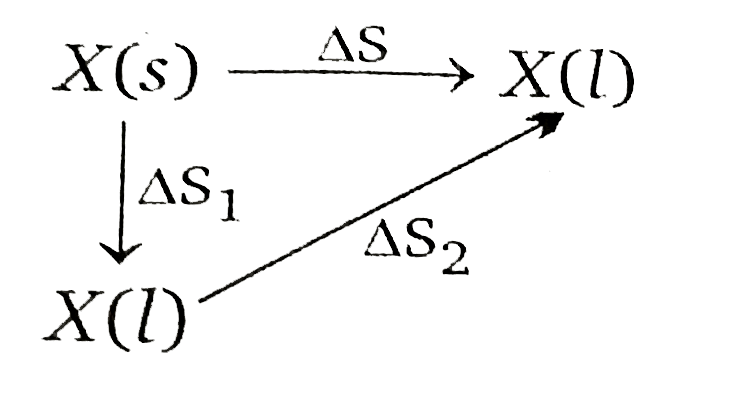Calculate ΔS for following process :
X(s)at100K→X(l)at200K
Given : Melting point of Xs=100K,ΔHFusion=20kJ/mol,Cp.m(X,l)=10J/mol.KSolution in Telugu
26.93J/K
206.93J/K
203J/K
206.93kJ/K
The correct Answer is:B

ΔS=20×1000100+1×200∫100CpmdTT
ΔS=200+10ln2=200+10×0.693,
ΔS=206.93 JK−1
Topper's Solved these Questions
- THERMODYNAMICSBOOK - NARENDRA AWASTHICHAPTER - THERMODYNAMICSEXERCISE - Level 1 (Q.1 To Q.30)
6 Videos
- THERMODYNAMICSBOOK - NARENDRA AWASTHICHAPTER - THERMODYNAMICSEXERCISE - Level 1 (Q.31 To Q.60)
2 Videos
- STOICHIOMETRYBOOK - NARENDRA AWASTHICHAPTER - STOICHIOMETRYEXERCISE - Level 3 - Subjective Problems
20 Videos
Similar Questions
A system undergoes a process in which ΔU=+300J while absorbing 400 J of heat energy and undergoing an expansion against 0.5 bar. What is the change in the volume (in L)?
View SolutionA gas expands against a variable pressure given by P=20V (where P in atm and V in L). During expansion from volume of 1 litre to 10 litre, the gas undergoes a change in internal energy of 400 J. How much heat is absorbed by the gas during expansion?
View SolutionWhat volume of a liquid (in L) will contain 10 mole ? If molar mass of liquid is 280 and its density is 1.4 g/mL.
View Solution5 mole of ideal gas at 100K(C_(v.m)=28J//mol//K) . It is heated upto 200 K. calculate triangleU and triangle(PV) for the process (R=8J//mol-K)
View SolutionThe enthalpy of combustion of propance (C_(3)H_(8)) gas in temes of given of geven data is , Bond energy (kJ/mol) underset(+x_(1))(.^(epsi)C-H)underset(+x_(2))(.^(epsi)O-O)underset(+x_(3))(.^(epsi)C-O)underset(+x_(4))(.^(epsi)O-H)underset(+x_(5))(.^(epsi)C-C) [Resonance energy of CO_(2) is -z KJ/mol and DeltaH_("vaporization")[H_(2)O(l)" is y " KJ//mol]
View SolutionWhat is the melting point of benzene if DeltaH_("fusion")= 9.95kJ//mol and DeltaS_("fusion")= 35.7J//K-"mol"
View SolutionCalculate ΔS for following process :
X(s)at100K→X(l)at200K
Given : Melting point of Xs=100K,ΔHFusion=20kJ/mol,Cp.m(X,l)=10J/mol.K
View SolutionWhat is the melting point of benzene if ΔHfusion=9.95kJ/mol and ΔSfusion=35.7J/K−mol
View SolutionMelting point of a solid is x K and its latent heat of fusion is 600 cal mol−1. The entropy change for fusion of 1 mol solid is 2 cal mol−1K−1. The value of x will be:
View SolutionCalculate the DeltaH_(f)^@ of C_(6)H_(12)O_(6) (s) from the following data: DeltaH_(comb)[C_(6)H_(12)O_(6)(s)]=-2816.kJ//mol DeltaH_(f)^(@) of CO_(2)(g)=-393.5kJ//mol DeltaH_(f)^(@) of H_(2)O(l)=-285.9kJ//mol
View SolutionAssuming ΔH∘andS∘ do not change with temperature. Calculate, the boiling point of liquid A uing the thermodynamic data given below:
Thermodynamic dataΔH∘(kJ/mol)S∘(JK−1mol−1)A(l)−130100A−100200(g)
View SolutionCalculate the entropy of a substance at 600 K using the following data. (i) Heat capacity of solid from 0 K to normal melting point 200 K C_("P.m.")(s)=0.035T" "JK^(-1)mol^(-1) (ii) Enthalpy of fusion = 7.5kJmol^(-1) , (iii) Enthalpy of vaporisation = 30kJmol^(-1) . (iv) Heat capacity of liquid from 200 K to normal boiling point 300KC_("P.m")(l)=60+0.016TJK^(-1)mol^(-1) (v) Heat capacity of gas from 300 K to 600 K at 1 atm C_("P.m")=50.0" "JK^(-1)mol^(-1) .
View SolutionWhat is the melting point of benzene if ΔHfusion=9.95kJ//molandΔSfusion35.7J/K−mol ?
View Solution(S∘(298K)JK−1mol−1)(H+(aq))+OH−(aq)−10.7J/mol/K→H2O(l)+70/mol/K
उपरोक्त अभिक्रिया के लिए मानक एन्ट्रॉपी परिवर्तन है
View SolutionWhat is the melting point of benzene if ΔHfusion=9.95kJ/molandΔSfusion=35.7J/K−mol?
View SolutionWhat is the melting point of benzene if ΔHfusion=9.95kJ/mol and ΔSfusion=35.7J/K−mol
View Solution
